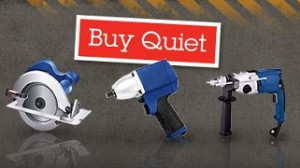Buy Quiet Update
Posted on by Several years ago NIOSH started the planning process for a “buy quiet” initiative to encourage companies to purchase or rent quieter machinery and tools to reduce worker noise exposure. This initiative also aimed to provide information on equipment noise levels and promote manufacturers to design quieter equipment. NIOSH is now pleased to announce the official launch of our Buy Quiet web resources, complete with a website and educational materials. The new, easy to use materials highlight the benefits of a Buy Quiet program, explain how to establish a program in a workplace, and provide additional resources for finding quieter tools and machinery.
Several years ago NIOSH started the planning process for a “buy quiet” initiative to encourage companies to purchase or rent quieter machinery and tools to reduce worker noise exposure. This initiative also aimed to provide information on equipment noise levels and promote manufacturers to design quieter equipment. NIOSH is now pleased to announce the official launch of our Buy Quiet web resources, complete with a website and educational materials. The new, easy to use materials highlight the benefits of a Buy Quiet program, explain how to establish a program in a workplace, and provide additional resources for finding quieter tools and machinery.
Noise-induced hearing loss is the most common work-related illness in the United States. Each year, approximately 22 million U.S. workers encounter noise exposures loud enough to be potentially hazardous. Buy Quiet can play an important role in protecting workers from these dangerous noise levels.
NIOSH’s Buy Quiet effort is part of the broader Hearing Loss Prevention Program, which conducts research on the causes of occupational hearing loss and works to deliver practical prevention solutions to employers. More information on NIOSH’s Hearing Loss Prevention Program can be found on the NIOSH Noise Topic Page. Buy Quiet is also a specific application of the NIOSH Prevention through Design (PtD) Initiative. PtD seeks to prevent or reduce job-related injuries, illnesses, and deaths through the use of prevention efforts in all designs that impact workers. Buy Quiet addresses this vision by decreasing noise hazards early in the life cycle of equipment and machinery, thus reducing the risk of noise-induced hearing loss.
Benefits of Buy Quiet include more than just reducing the risk of hearing loss at the worksite. Buy Quiet programs will minimize the impact of noise on communities and help companies comply with OSHA and other noise regulation requirements as well. Additionally, Buy Quiet may reduce the long-term costs of audiometric testing, personal protective equipment, and workers’ compensation.
The Buy Quiet Construction video builds the case for why you should Buy Quiet in the construction industry. Click the image below to watch this educational video.
Effective Programs
Buy Quiet can be carried out in a number of ways, but ideal programs may contain the following:
- An inventory of existing machinery and tools with corresponding noise levels. The company’s purchaser can use the inventory to compare noise levels of equipment before buying or renting. The inventory can also be used for assisting, tracking, and promoting a company’s Buy Quiet purchases.
- A Buy Quiet company policy or procedure. Policy can be an easy and effective way for employers to show commitment to protecting the hearing and well-being of their employees by using the best equipment available.
- Educational materials and promotional tools. These resources should be designed to help inform employees, management, customers, and the community about the importance and benefits of Buy Quiet. NIOSH has developed a series of posters for construction companies to post at their worksites. View and print posters here.
- Cost-Benefit Analysis of Buy Quiet programs. In many cases, the quieter piece of equipment is the least expensive when all life cycle costs of the machinery, possible workers’ compensation claims, costs associated with a company’s hearing conservation program, costs of healthcare (such as hearing aids), and lost productivity are counted.
We are asking you to help promote Buy Quiet by raising awareness among workers and employers about noise-induced hearing loss and by providing information they can use to encourage work-related safety. Be part of a nationwide effort to reduce noise-induced hearing loss.
Join us:
- Get the word out! Put a Buy Quiet link on your website, an announcement in your newsletter, a post on your Facebook page, or follow @NIOSHNoise on Twitter and re-tweet us.
- Print and distribute Buy Quiet posters and hang them at your worksite.
- Promote, host, or sponsor Buy Quiet presentations. Contact us to learn more.
- Reach out to new partners in government, labor, and industry and talk about Buy Quiet.
- Assist with evaluating the effectiveness of Buy Quiet initiatives.
To learn more and start preventing hearing loss through buy quiet initiatives, please visit the Buy Quiet webpage or contact the NIOSH Division of Applied Research and Technology, Engineering and Physical Hazards Branch, Hearing Loss Prevention Team at 513-841-4221.
Holly Poynter, MPH; Trudi McCleery, MPH; and CAPT Charles S. Hayden, MS, PE
Ms. Poynter is a student intern in the NIOSH Division of Applied Research and Technology.
Ms. McCleery is a health communication specialist in the NIOSH Division of Applied Research and Technology.
CAPT Hayden is a mechanical engineer in the NIOSH Division of Applied Research and Technology
Posted on by



